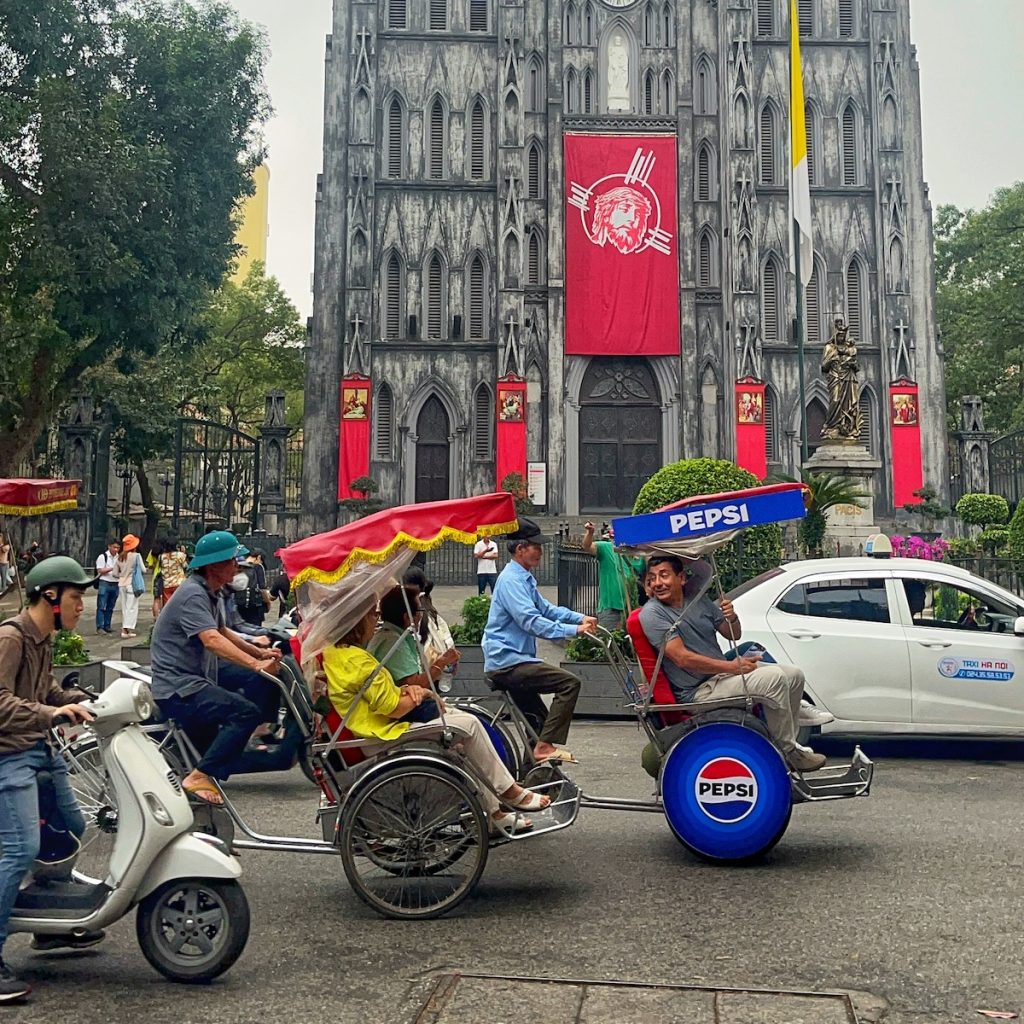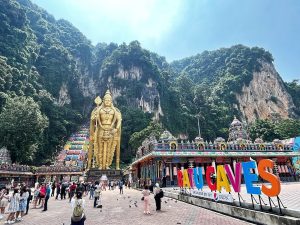This one-day in Hanoi itinerary is for those who love to wander on foot as much as possible.
I’ll level with you, though – if you like to walk a lot on your travels, I am guessing you will probably appreciate walkable cities with crisp air, inviting wide pavements and fancy, beautiful boulevards.
Hanoi is not one of those cities; most people in Vietnam drive motorbikes to get around. The streets are narrow, the air quality is terrible, the traffic is chaotic, and it’s generally loud.
However, all of these incredible places that I am about to share with you are within walking distance of one another, resulting in a very convenient and productive day in Hanoi.
So, you will exercise by getting those steps in while ticking off your Hanoi bucket list as you trot along your journey.
1 Day in Hanoi Itinerary: The Best Bits On Foot
I recommend spending more than one day in Hanoi. This article is just based on my perfect day out of 4 that I recently spent in the city; I jam-packed all of these activities into one busy day, but I never felt like I was rushing.
My first visit to Vietnam was incredibly frustrating. I did not foresee myself waxing lyrical about the place anytime soon in my blogging life or from my honest lips, yet here I am after spending four days in the capital city, wishing I had spent more days there.
With a visa run on the horizon from my adopted city, Chiang Mai, I acted on the strong desire to offer an olive branch to Vietnam after an 8-year grudge that I no longer wanted to feel the burden of.
I genuinely believe this one-day Hanoi itinerary is the best one out there (including those that contain that boring Bourdain/Obama plastic stool I had no desire to see). Still, you have to account for tastes and get up really early (something I don’t love, but it’s often worth it).
Getting There For Your 1 Day in Hanoi & Where To Stay
Staying in the Old Quarter part of Hanoi is a no-brainer as it’s the heart of Hanoi’s rich culture and history, its origins dating back over a thousand years. The area is also the best place for accessibility and convenience, nightlife, shopping, food and accommodation options.
The most convenient way to reach Hanoi from anywhere in Southeast Asia is by air. Hanoi’s Noi Bai International Airport (HAN) is the main gateway for international travellers.
Direct Flights
There are direct flights to Hanoi from major cities in Southeast Asia such as Bangkok, Singapore, Kuala Lumpur, Manila, Jakarta, and more. Airlines such as Vietnam Airlines, Thai Airways, Singapore Airlines, Malaysia Airlines, and budget carriers like AirAsia, Jetstar, and VietJet offer frequent services.
Connecting Flights
For cities without direct flights, connecting flights usually go through major hubs like Bangkok, Singapore, or Ho Chi Minh City.
By Land
Land crossing into Vietnam is an option for travellers from neighbouring countries: China, Laos, and Cambodia. There are several border crossings, but the logistics and journey time can make it less convenient than flying. However, it’s an ideal adventure for those looking for overland travel experiences.
- From China: You can enter Vietnam at several border crossings, such as Mong Cai (near Halong Bay), which is relatively close to Hanoi. Buses and trains are available from cities like Nanning and Kunming to Hanoi.
- From Laos: The most popular border crossing is at Lao Bao in central Vietnam. Though it’s a long journey, you can catch a bus to Hanoi from there. Another route is through Dien Bien Phu, from where buses run to Hanoi.
- From Cambodia: You would typically enter Vietnam through the Moc Bai border crossing, then travel by bus to Ho Chi Minh City and catch a flight or another long-distance bus to Hanoi. Though it’s quite a lengthy trip, direct bus services from Phnom Penh to Hanoi are also available.
By Train
The international train from Beijing to Hanoi offers a unique journey for those in China, taking about two days and passing through stunning landscapes. Still, it’s more about the experience than speed or convenience.
Start Your 1 Day in Hanoi Itinerary With a Local Coffee
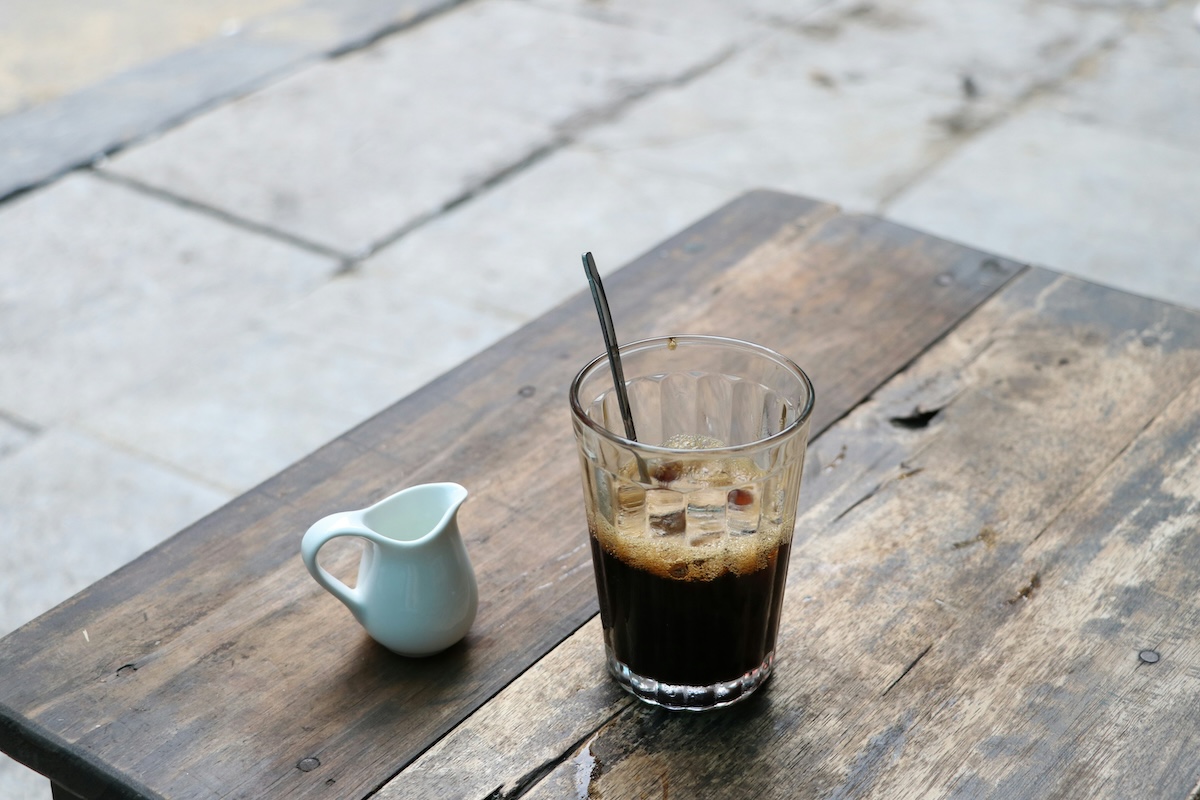
You will have a busy day and need to be at your first destination by 7:30 a.m., so shortly upon waking, it’s time for that popular face-slap in a mug.
Vietnam has a famous and unique coffee culture and is the second-largest coffee producer in the world.
Vietnamese coffee is traditionally brewed in a small metal drip filter (phin), making the coffee experience somewhat ritualistic and highly enjoyable. The slow drip of the coffee into the cup adds to the anticipation and richness of flavour.
Signature Vietnamese Coffee Drinks in Hanoi
Hanoi offers a variety of unique coffee creations; pick one of these for your morning brew.
- Cà Phê Sữa Đá: Iced coffee with sweetened condensed milk, a staple in the Vietnamese coffee scene.
- Egg Coffee (Cà Phê Trứng): A Hanoi speciality, this drink is made with egg yolks, sugar, condensed milk, and coffee, creating a creamy, rich concoction reminiscent of tiramisu.
- Yogurt Coffee (Cà Phê Sữa Chua): Coffee is mixed with sweetened yoghurt to create a tangy and refreshing drink.
- Coconut Coffee (Cà Phê Dừa): A smooth blend of coffee and coconut milk or cream, served iced and often sweetened.
- Black: Or just be boring like me and order it hot and black. Make sure it’s local to feel less like a filthy philistine.
You will find plenty of coffee places around the Old Quarter of Vietnam early in the morning, such as Giảng Café, Café Duy Trí, and Café Năng (to name a few). Ensure you are fully caffeinated and ready to leave at 7 am for your half-hour walk to Ho Chi Minh’s Mausoleum.
Ho Chi Minh’s Mausoleum

Ho Chi Minh’s Mausoleum is of profound national significance for most Vietnamese people. It is located in the centre of Ba Dinh Square, where President Ho Chi Minh read the Declaration of Independence from France on September 2nd, 1945, establishing the Democratic Republic of Vietnam.
It’s also home to his preserved body, which you can see behind a large glass cabinet.
This is commonplace in communist/former communist countries as preserving bodies of deceased leaders tip their hats towards their legacy and ideology while adding to their cult of personality.
Sadly, I have encountered lousy luck for a curious fella like me while attempting to see this for myself.
When I first visited Hanoi, it was impossible to see him as he was getting fixed up. When I was in Russia, the same thing happened to Vladimir Lenin’s body, and my trip to Beijing coincided with a holiday that prohibited viewing the embalmed body of Chairman Mao.
It was the same deal for me wanting to see the two preserved Kims during my visit to North Korea. Che Guevara’s mausoleum doesn’t showcase his body, although a trip there was a perfect swansong to seven perfect days in Cuba.
I finally broke my embalmed communist leader duck, seeing who patriotic Vietnamese people affectionately refer to as “Uncle Ho” after queuing in the gigantic queue from 7:20 am to an impressively efficient time at 8:30 am.
I was disheartened upon arrival as I thought I was punctual. I had arrived 10 minutes before opening, and I saw the line and thought I might fail today.
But the soldiers there do not f**k about, and the two queues that form once you enter the grounds (for free of charge) are expertly dealt with by the Vietnamese soldiers who have zero tolerance for dawdling, photography in prohibited areas and especially for noise as people got closer to the body.
It goes without saying that if you choose to do this, do it most respectfully. Think about the clothing that you wear (male and female). Put away your phone/camera when asked, and keep quiet as you approach the mausoleum. This place is as sacred to locals as a mosque in Afghanistan or visiting Angkor Wat in Cambodia.
You will enter the striking large square building and walk anti-clockwise around the glass cabinet while being ushered by soldiers to hurry up and shut up, and you will be able to see the body for about 30 seconds.
When I did this, I received many judgy, icky comments like “Why would you be interested in doing something like that?” Quite frankly, I don’t feel the need to explain myself—I simply had an interest in doing it, and if you don’t, this is also fine.
You do you!
The grounds offer an impressive Presidential Palace, Ho Chi Minh’s Stilt House, and a museum for those not interested in seeing Ho Chi Minh’s body. Hence, if you are with a group, you can easily sync up to tailor your visit to tourist tastes.
Lenin Park
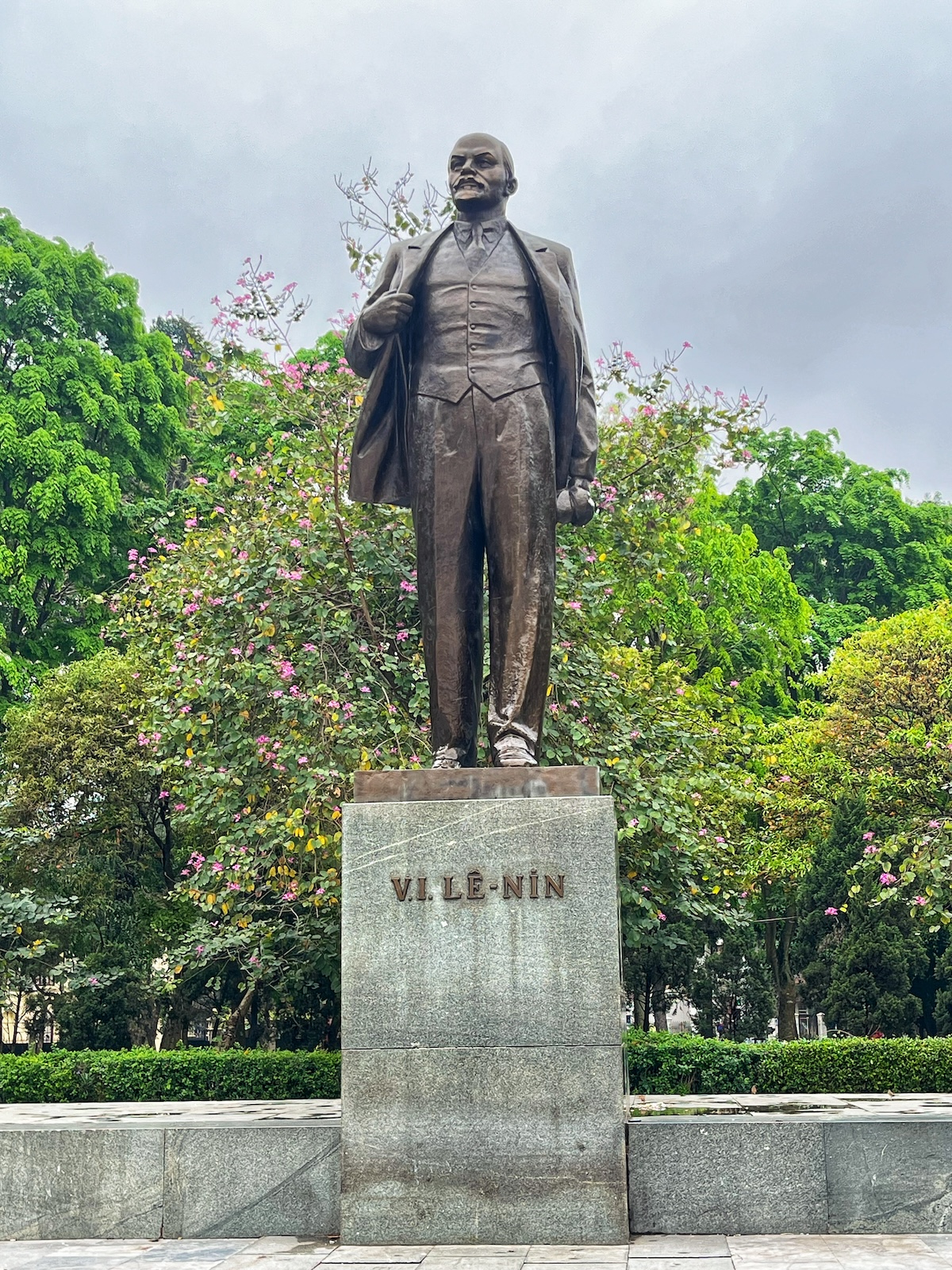
Sticking with the communist icon theme is Lenin Park, a short 10-minute walk from the Mausoleum. It’s a nice spot to reflect and enjoy greenery, with the famous polarising baldie towering 17 feet over you in bronze form.
There isn’t much to see besides the main man it’s named after, although there is a decent amount of greenery to walk about in if you want to decompress from the intense experience at the Mausoleum.
This statue is also the only statue of Lenin in the whole of Southeast Asia… there’s a potential obscure point for your next pub quiz.
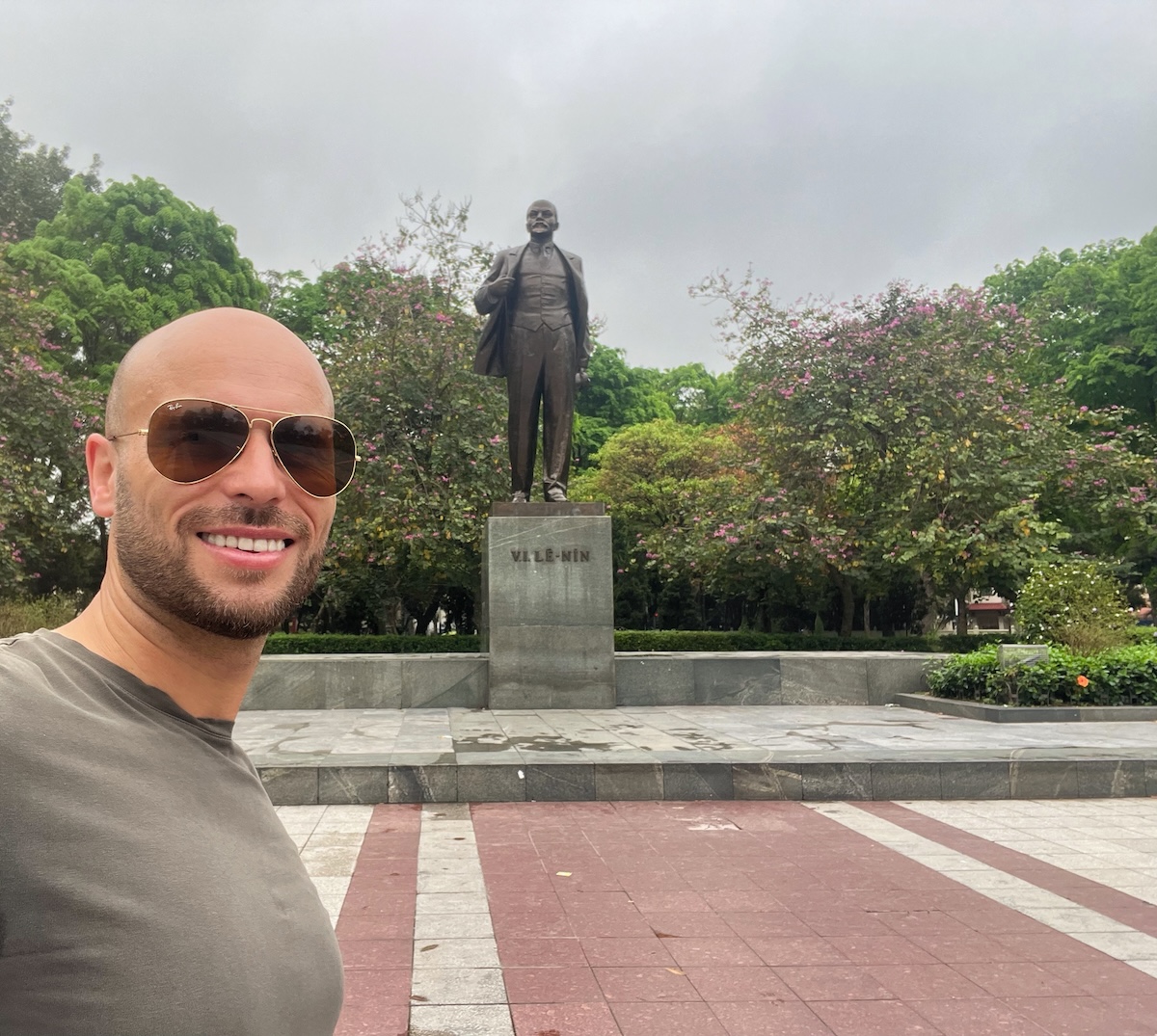
Tran Quoc Pagoda
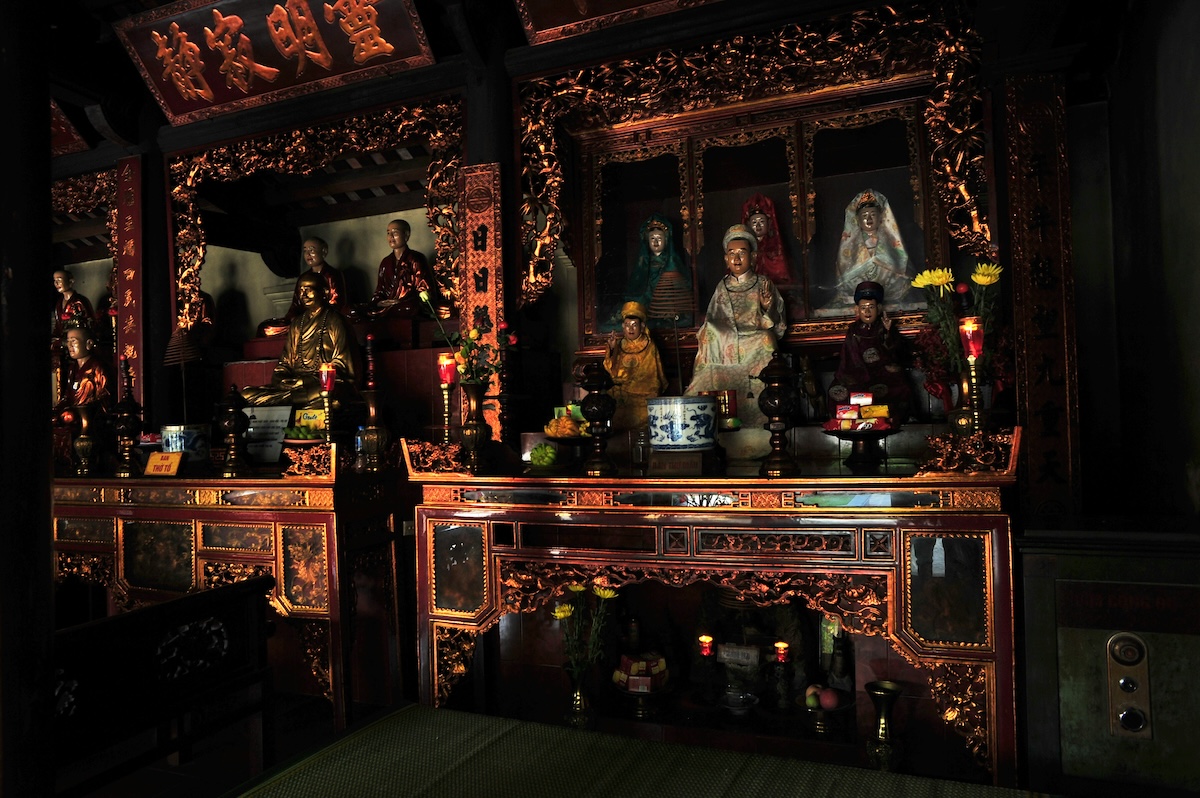
Time for another 30-minute walk (don’t worry, my fellow hangry folk, I have food plans coming up).
After Lenin Park, head to Tran Quoc Pagoda. It is nestled on the eastern shore of Hanoi’s West Lake and is the oldest Buddhist temple in the city, at 1,480 years old.
For those suffering from “temple fatigue” while travelling in Southeast Asia and considering skipping this, don’t.
I live in Thailand and have visited every country in Southeast Asia and I was wowed by it. This temple is special not only because of its historical background but also because it’s rightly referred to as one of the most beautiful temples in the whole of Vietnam.
Two main things to remember about this place: it is closed from 12 pm to 1:30 pm, and if you want to join others offering the monks food at any time, make sure you don’t bring meat as they are all strictly vegetarian.
Eat a Bánh Mì for Breakfast
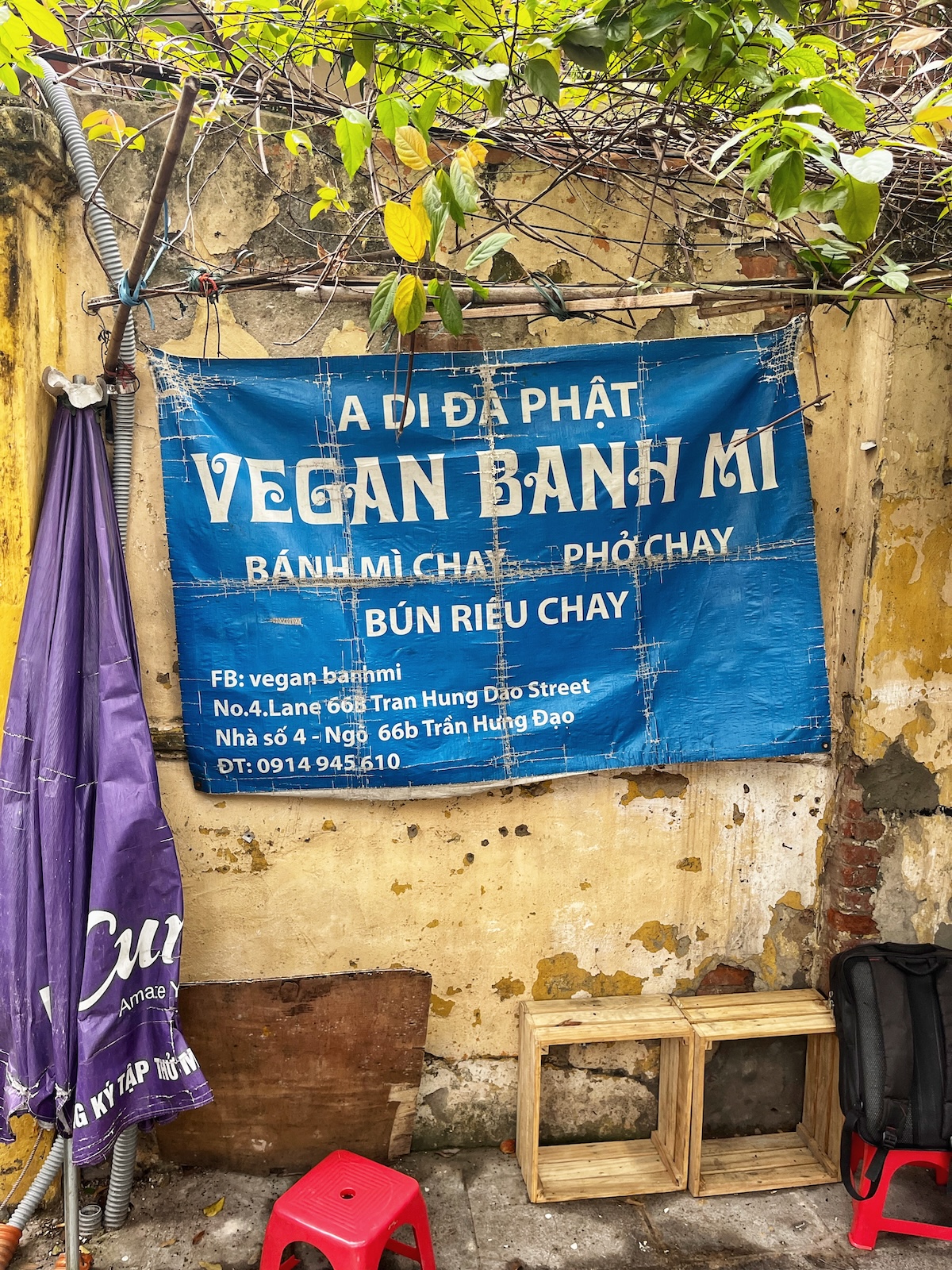
You didn’t think that I was one of those cruel people who give you a busy itinerary without thinking about your rumbling belly, did you?
No chance! Now it’s time for a bangin’ brekkie “Banh Mi.”
Banh Mi is a quintessential Vietnamese sandwich that has gained international fame for its delicious blend of flavours and textures.
A product of French colonial influence in Vietnam, bánh mì perfectly embodies the fusion of French and Vietnamese culinary traditions. The Vietnamese baguette is lighter, airier, and has a thinner crust than its French ancestor, which makes it distinctively crunchy on the outside and soft on the inside. The unique texture is partly due to rice flour and wheat flour use.
Ingredients of Banh Mi
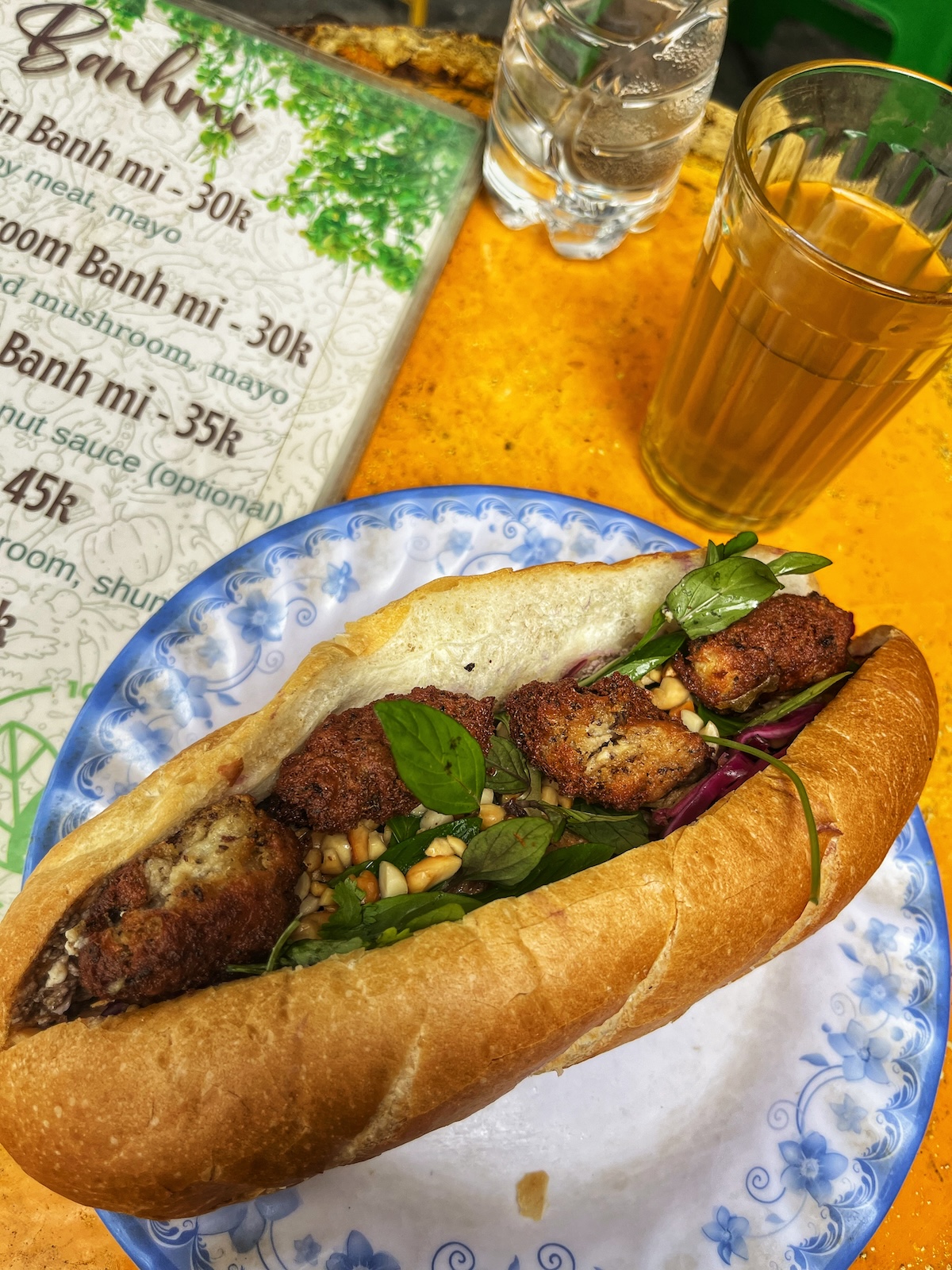
A traditional bánh mì sandwich typically includes:
Protein: Common fillings include grilled pork, pâté, chicken, or tofu/TVP for vegetarian versions.
Pickled Vegetables: Carrots and daikon radish, thinly sliced and pickled in a mixture of vinegar, sugar, and water add a sweet and tangy crunch.
Cucumber: Fresh cucumber slices add a crisp freshness.
Herbs: Cilantro is a staple herb that contributes to a burst of flavour.
Chillies: Freshly sliced chillies for those who prefer a bit of heat.
Mayonnaise: A holdover from French culinary tradition, mayo adds creaminess.
Soy Sauce or Maggi Seasoning: Used for seasoning.
Now, here’s the fun part… I am setting you free into the streets to find your own Banh Mi. Do me proud.
It’s time to go rogue, fellow traveller.
I wouldn’t leave you in the lurch if it were too hard of a task.
Your next stop is another 30-minute walk, and you need to carb up, safe in the knowledge that you can barely walk 5-10 minutes in Hanoi without seeing a Banh Mi shop.
I went to “Vegan Banh Mi,” a traditional plant-based place so delicious that I had three! This one is a little out of your way for your current spot (an hour’s walk), so feel free to put it on your list for another day.
Don’t venture too far, as you have another activity you must walk to, and the one after that may have extra time restrictions. So good luck with your Banh Mi mission, and enjoy every bite.
I believe in you.
Downed B-52 Wreckage at Huu Tiep Lake
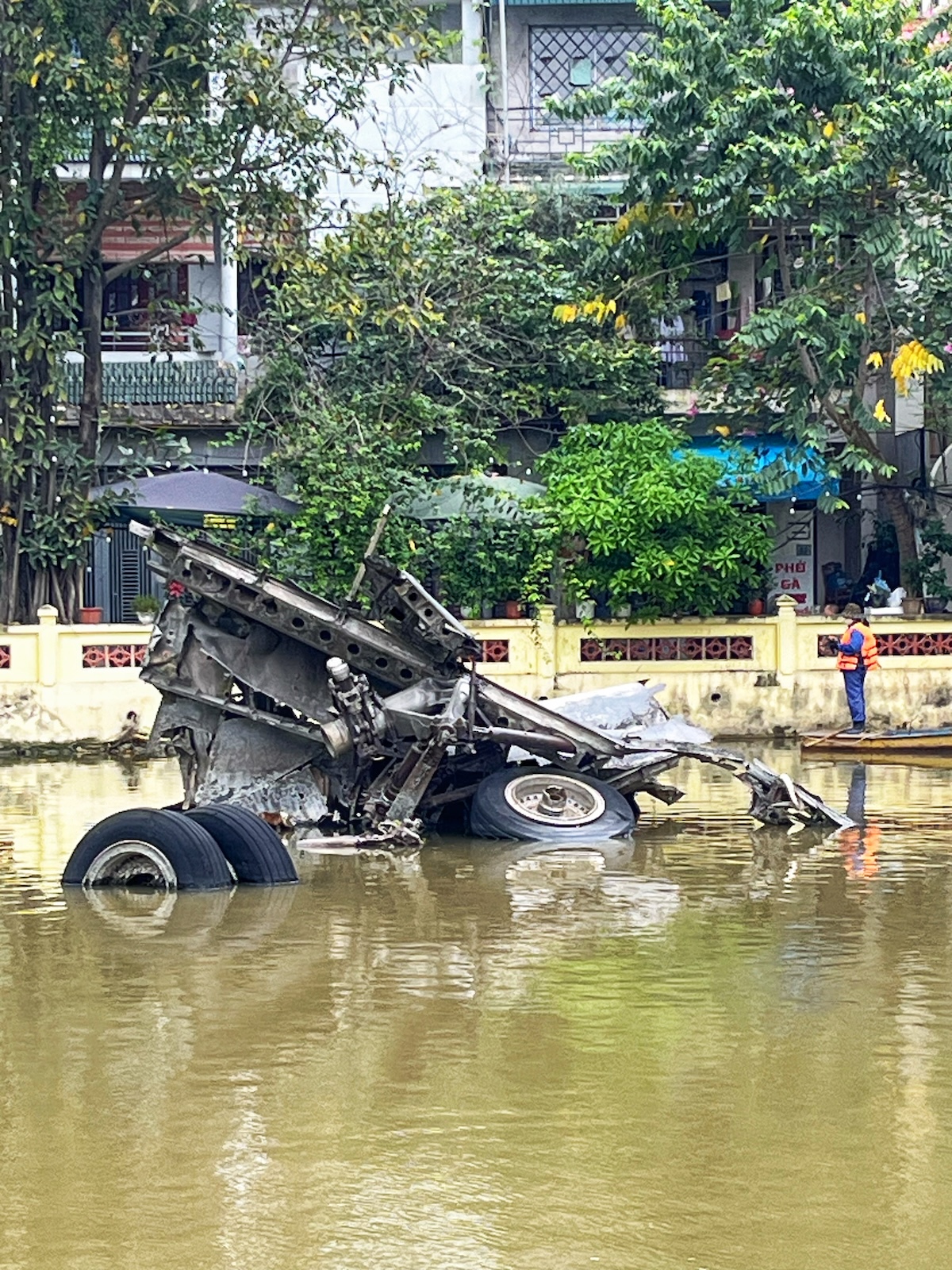
With your glycogen stores fully primed and ready to go, it’s time for a 30-minute walk to Huu Tiep Lake for a poignant and sobering part of Vietnam’s history by witnessing the downed B-52 wreckage at Huu Tiep Lake, located in the Ngoc Ha neighbourhood of Hanoi.
This submerged wreckage is a remnant of the Vietnam War, a conflict that spanned two decades and involved numerous countries, marking a period of profound pain and transformation for the country.
In Vietnam, referred to as the “American War” by the locals, this site embodies both the anguish of a nation’s past and the undying spirit of its people during the conflict.
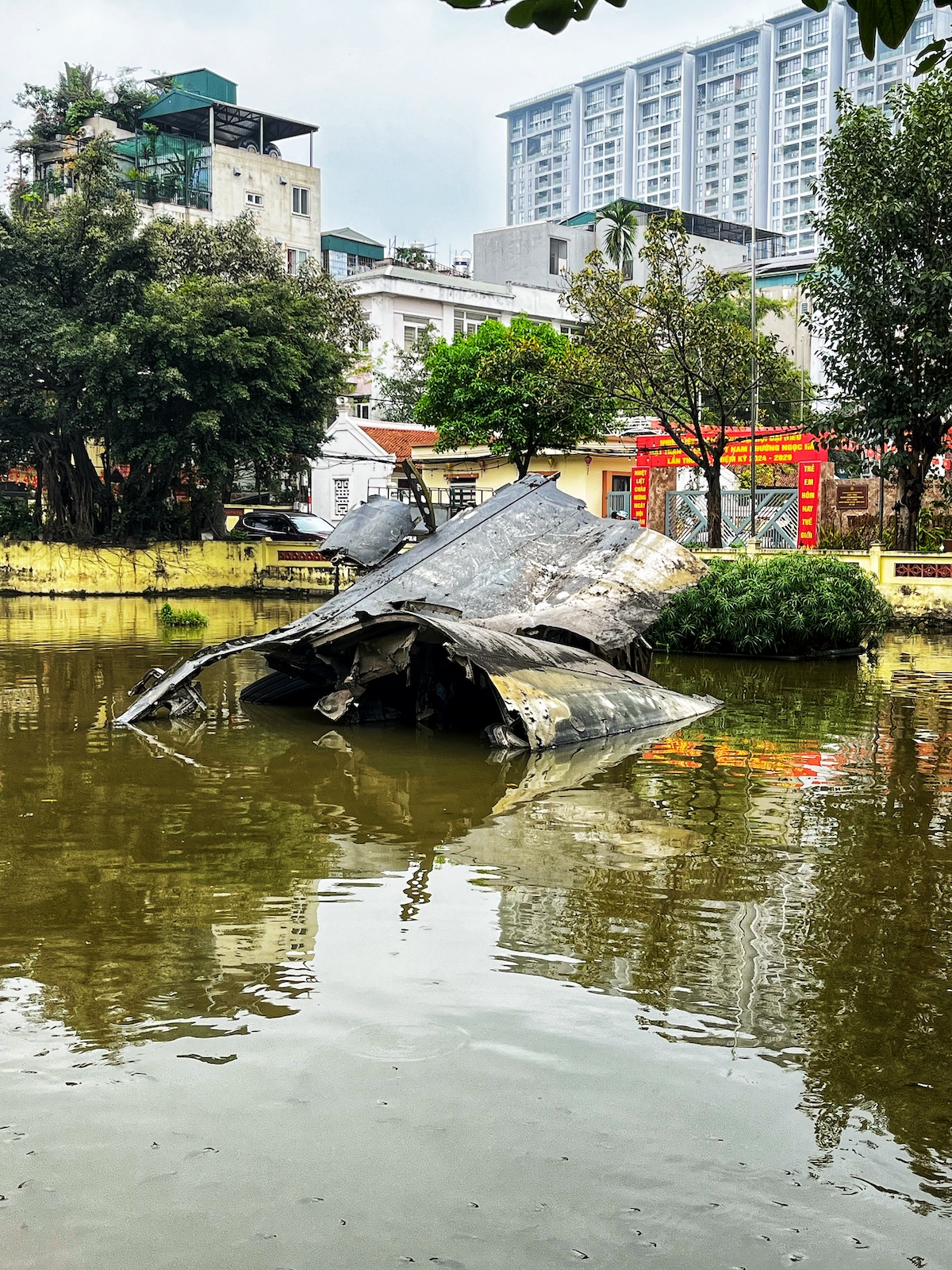
Among the most significant moments of the conflict was “Operation Linebacker II,” often called the “Christmas Bombing.” This intense campaign, conducted in late December 1972, aimed to hasten the end of the war by targeting strategic sites in North Vietnam, including Hanoi. The operation was marked by its ferocity and left deep scars on the landscape and the population.
The B-52 at Huu Tiep Lake crashed during this operation, making the site a profound reminder of the war in this part of the country. The wreckage is subdued in the water, with pieces of the aircraft still visible above the waterline,
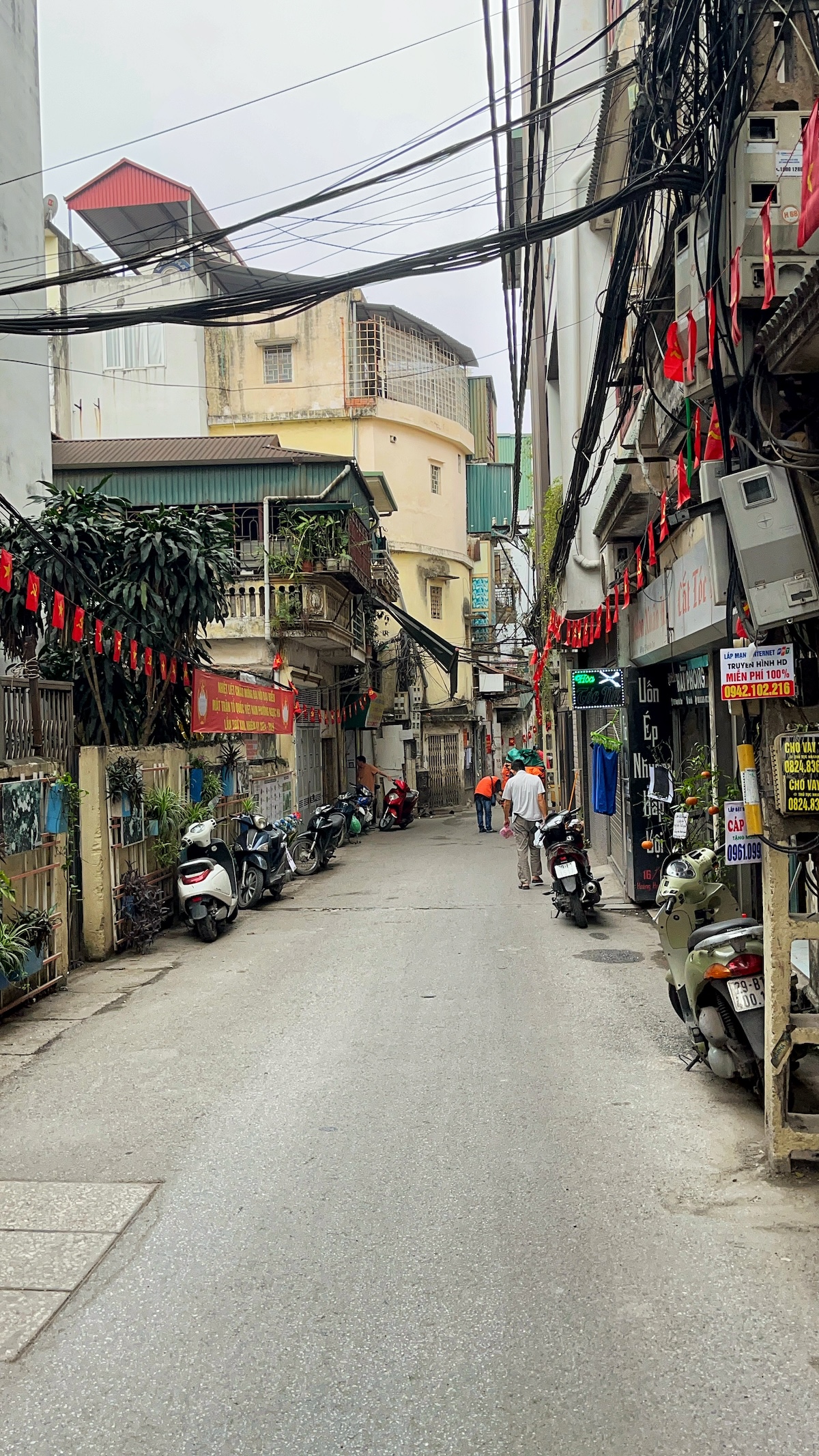
As you wander along Hoang Hoa Tham Avenue, where it intersects with Ngoc Ha Avenue, look for a narrow lane that leads to the lake, and it’s hard to miss the B-52 wreckage. I had a quick cuppa at one of the cafes surrounding the wreckage before moving on to the next stop, which is one of Hanoi’s top landmarks.
Hanoi Train Street
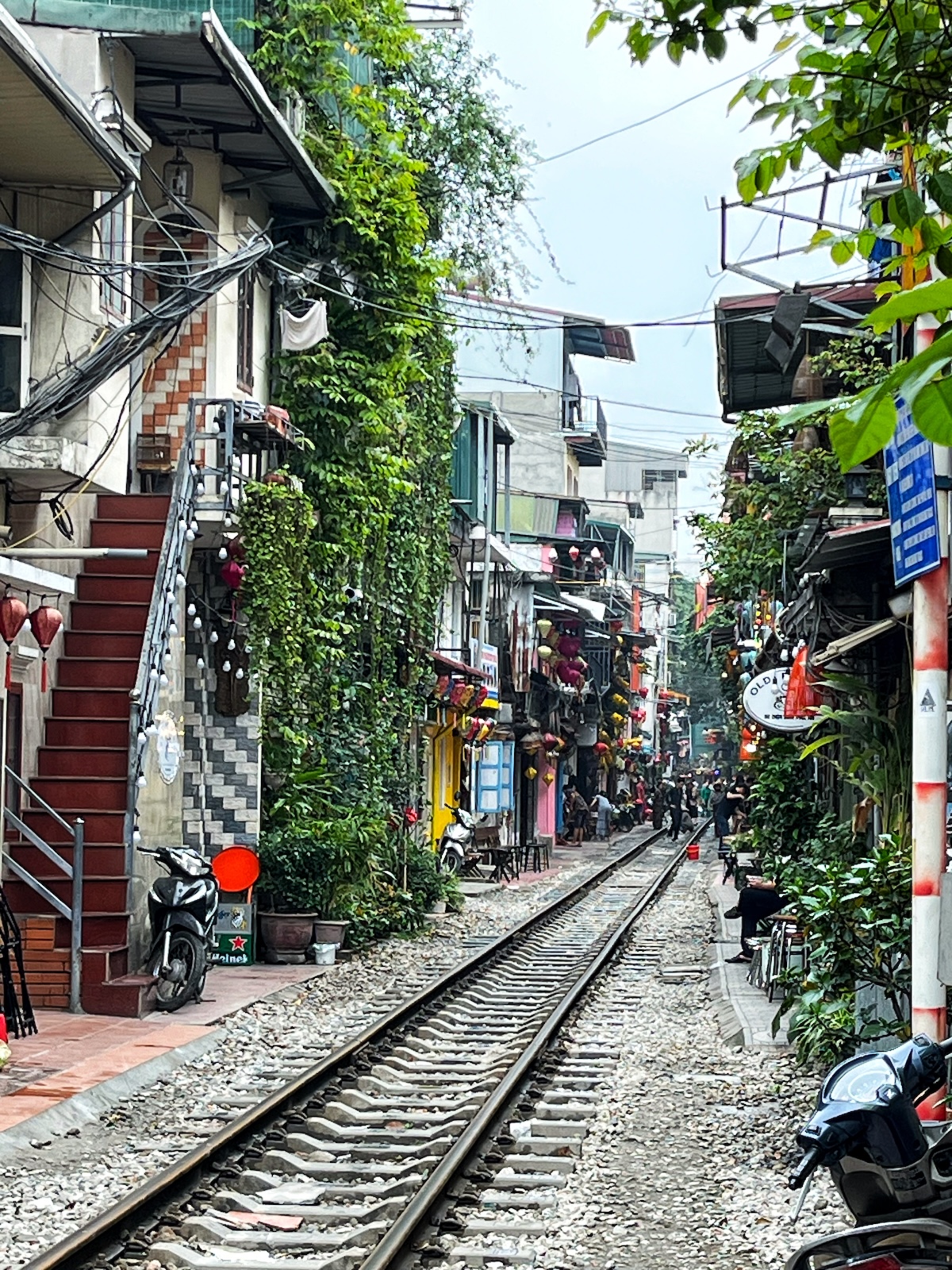
Hanoi Train Street is a reluctant Vietnam tourist gem you will likely see on your social media feed now that it’s part of your psyche.
Much like the Maeklong Railway Market in Bangkok, nestled in the heart of Hanoi’s Old Quarter, it is a narrow street where locals go about their day like any other household until a noisy train steals through the neighbourhood.
Built by the French in 1902, the street is part of the railway that connects the Vietnamese capital with other parts of the country. The everyday life that typically takes place alongside the tracks was transformed when locals recognised the business potential and began opening cafes. These quickly gained popularity among tourists, although some locals felt uncomfortable with the unwanted attention.
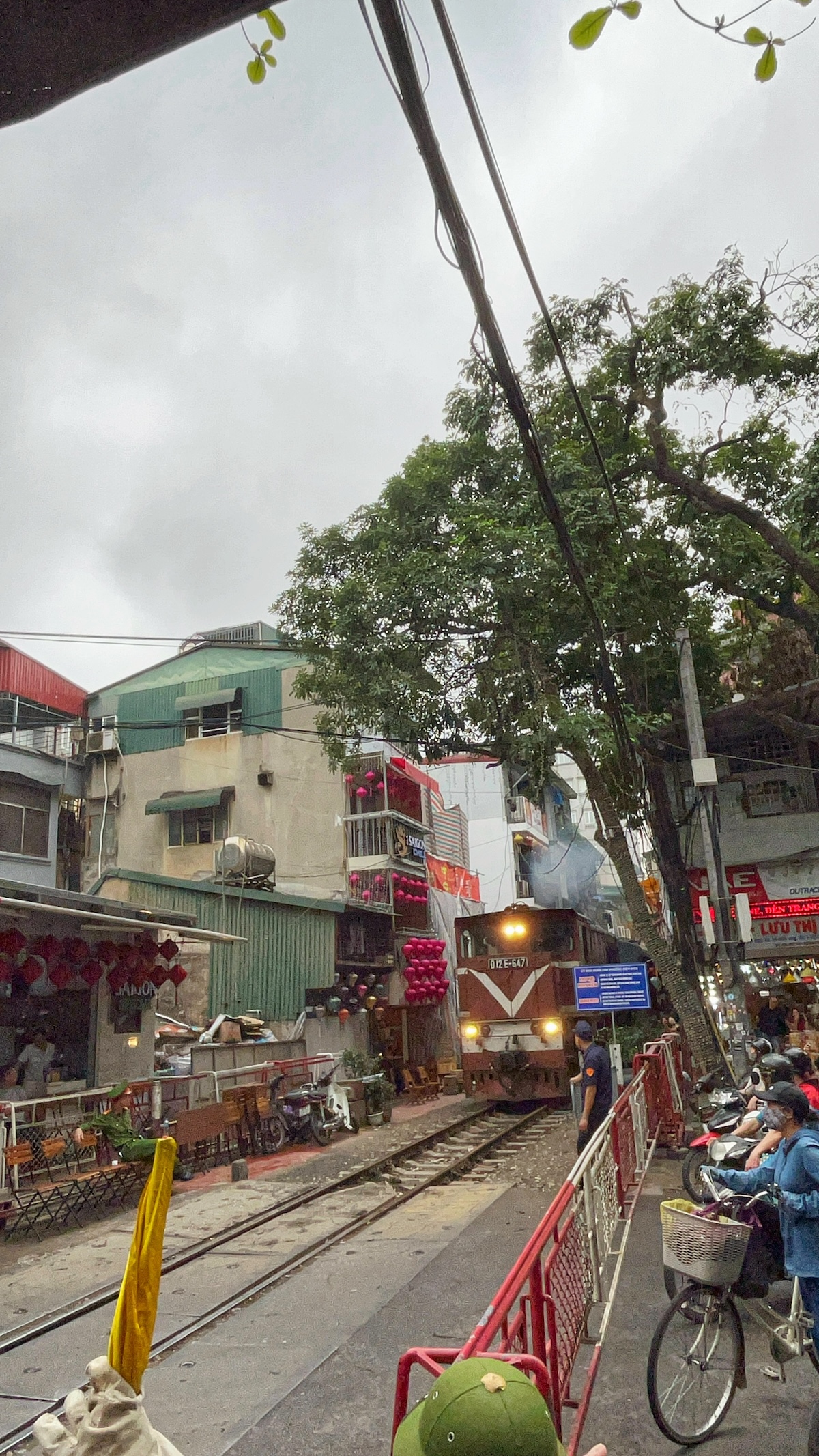
The train is said to come through Hanoi Train Street twice daily in the evening and more regularly (10 times per day) on weekends, but I lucked out on a Thursday around lunchtime. You don’t have to see the train if you don’t want to or are on a tight schedule and the trains aren’t always on time.
The photos of the place are iconic enough, but I think it’s worth waiting for the train to come. Plenty of excellent culinary and drink options are on the side of the tracks. Just ensure you behave yourself so you don’t irk the staff responsible for the railway.
As I said, I lucked out – the train arrived 5 minutes after I showed up just before lunch. If witnessing the train is an absolute must for you, then the best way to do this is to remove it from your one-day Hanoi itinerary and book a guided tour so that you can leave it to the experts and get your trainspotting on.
Go Pho Yourself!

It’s time for a heartier meal for lunch. Pho is a classic Vietnamese soup that has become a staple in Vietnamese cuisine and has gained international popularity recently.
Traditionally, pho combines broth, rice noodles, herbs, and meat—usually beef or chicken—although a vegetarian version (with tofu) is easy to find in Hanoi. The dish is known for its flavorful broth, which is simmered with spices such as star anise, cloves, cinnamon, and ginger to develop a rich and complex taste.
You can find a good Pho place as you move towards the central part of your itinerary, possibly after visiting Train Street. Regarding time logistics, killing two birds with one stone and grabbing one at the Train Street Cafe makes more sense.
However, if you liked my Banh Mi suggestion earlier, you may want to try something else.
I respect your foodie grind. Having a bad pho in Hanoi is hard, so you’re all good. Don’t stray too far; next, you’re off to see a rare piece of Gothic architecture.
St. Joseph’s Cathedral
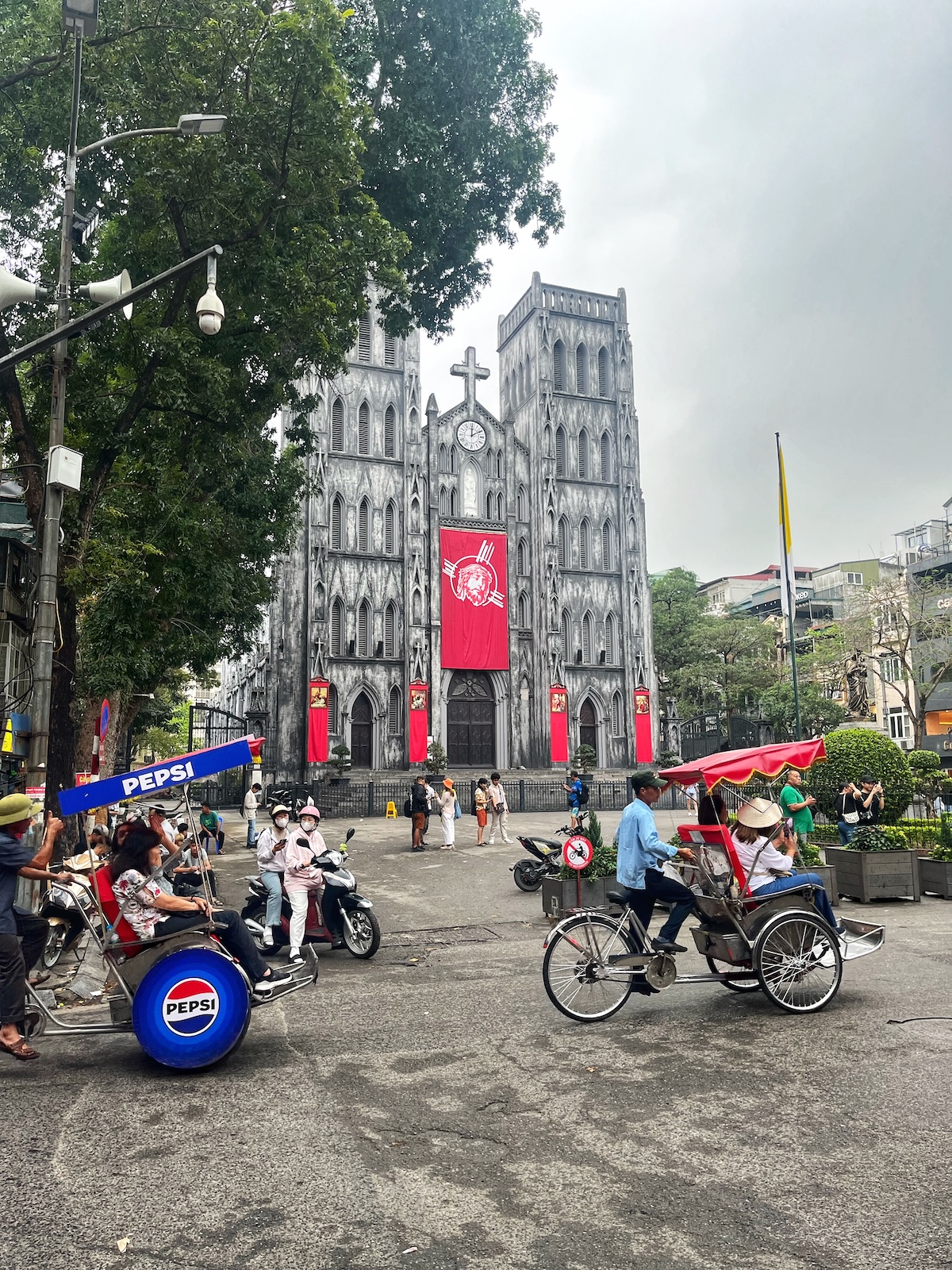
A 12-minute walk from Hanoi’s Train Street, St. Joseph’s Cathedral is a historically significant landmark and a beacon of French colonial legacy in the heart of Hanoi’s Old Quarter.
It’s the oldest church in Hanoi, having survived two major wars and retaining its peaceful presence amidst the city’s hustle and bustle. You can’t miss this impressive grey building towering over you as it looks entirely out of place compared to almost everything else in the city.
The cathedral is open to the public for free every day except Sundays when it is closed from 8 to 11 a.m. and 1 to 5 p.m.
Hoa Lo Prison Museum

Hoa Lo Prison is a 10-minute walk from St Joseph’s Cathedral. Initially built by the French colonial authorities in the late 19th century, it was intended to house Vietnamese prisoners, particularly political dissidents fighting for independence.
The prison, often referred to by the sarcastic name “Hanoi Hilton” by American prisoners of war during the Vietnam War, has a dark history marked by the harsh conditions and brutal treatment that inmates endured.
Former US Senator John McCain was famously known during his election campaign for being held as a prisoner of war at Hoa Lo Prison in Hanoi. He was captured by North Vietnamese forces in 1967 after his plane was shot down during the Vietnam War. McCain spent about five and a half years in captivity, and a significant portion of that time was spent at Hoa Lo Prison.
Today, the museum serves as a poignant reminder of the struggles against France and the later conflicts that Vietnam endured.
Visitors can explore exhibitions showcasing the prison’s history, including the French colonial period and the Vietnam War era. Artifacts, photographs, and personal stories are on display, providing insights into the life and conditions within the prison walls.
I usually skip museums, but this one was right by the cathedral, and I had time to kill. I spent 30 minutes there, paying only 15,000 VND (USD 1.30) and an extra USD 4 for an audio headset.
Pit-Stop at Hoan Kiem Lake
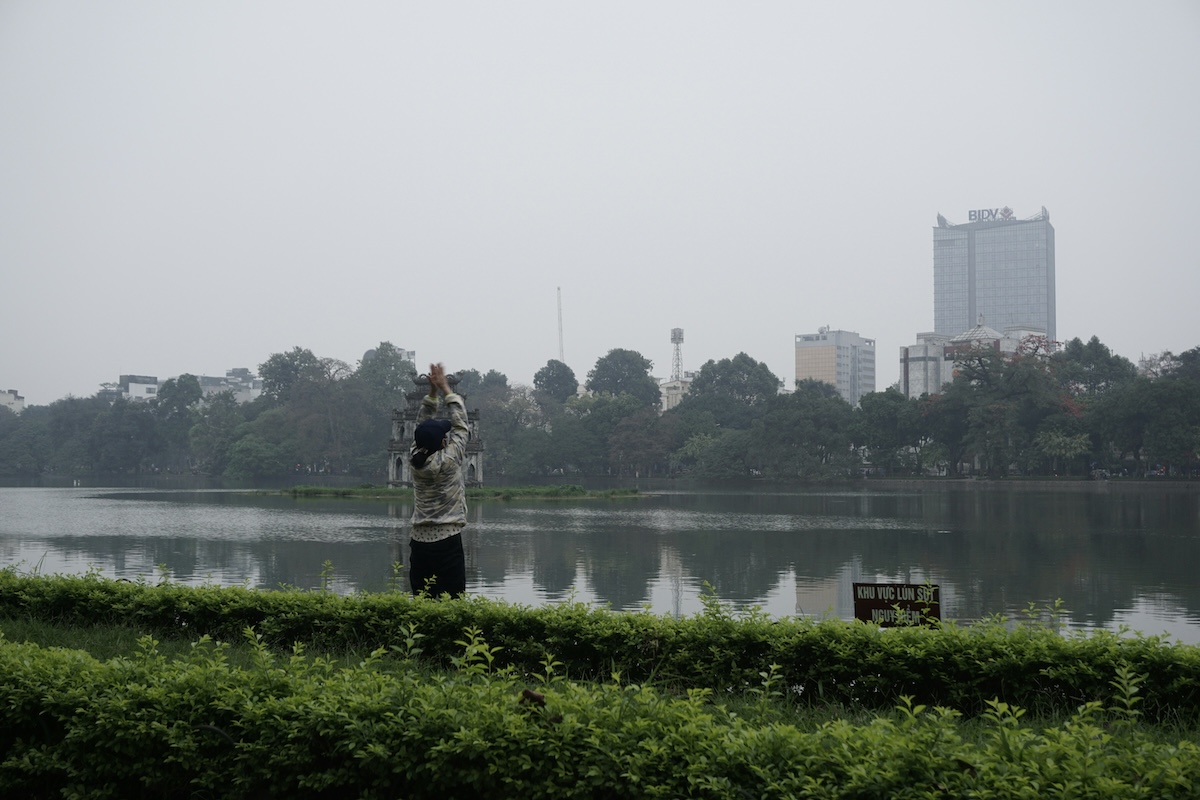
Hoan Kiem Lake offers a serene spot that’s perfect for late afternoon. It allows some digestion and reflection time after an intense morning and a previous heavy visit to the Hoa Lo Prison Museum.
It’s a twenty-minute walk away, and you’re getting some great, steady cardio while seeing the best of Hanoi. Good job.
The name “Hoan Kiem” translates to “Returned Sword,” referring to a legendary story about Emperor Le Loi, who was said to have been given a magical sword by the gods to expel invading Chinese forces. After his victory, a giant golden turtle god (Kim Qui) emerged from the lake’s waters and reclaimed the sword, returning it to its divine owners.
The Lake’s surroundings are beautifully maintained with trees, gardens, and pathways, making it a popular spot for morning exercises and leisurely walks for the Hanoi residents.
The impressive King Le Thai To statue is near Hoan Kiem Lake’s northern shore. This bronze statue commemorates his significant role in Vietnamese history, notably his victory over the Chinese Ming Dynasty in the 15th century.
I spent an hour here dawdling around before quenching my thirst, and then I walked 20 minutes more for the cheapest beer in the world…
Drink The World’s Cheapest Beer at Bia Hoi Ngoc Linh
For less than 25 cents a glass, you can enjoy what is often cited as “the cheapest draught beer in the world” on a quintessentially Vietnamese tiny street stool with locals and other travellers.
Bia Hoi Ngoc Linh is a popular spot in Hanoi, Vietnam, renowned for serving “Bia Hoi,” a type of Vietnamese draft beer that is famously inexpensive and freshly brewed daily. Bia Hoi is a cultural staple in Vietnam, particularly in the northern regions, including Hanoi. The beer is light in alcohol content, usually around 3-4%, making it a refreshing choice in the hot and humid climate.
The beer went down a treat, but now it’s time to get back to your hotel and shower/rest before putting on your fanciest gear and heading out for a delicious culinary experience, which you have genuinely earned after burning all those calories on your busy day.
Sadhu Vegetarian Restaurant

Carnivores… put those pouty lips away.
No one is forcing you to go here if you don’t want to, but I can assure you that you’ll miss out if you do. You can go one meal without meat, and you won’t meet a fate worse than death. This place is popular amongst veggies, vegans, and omnivores alike.
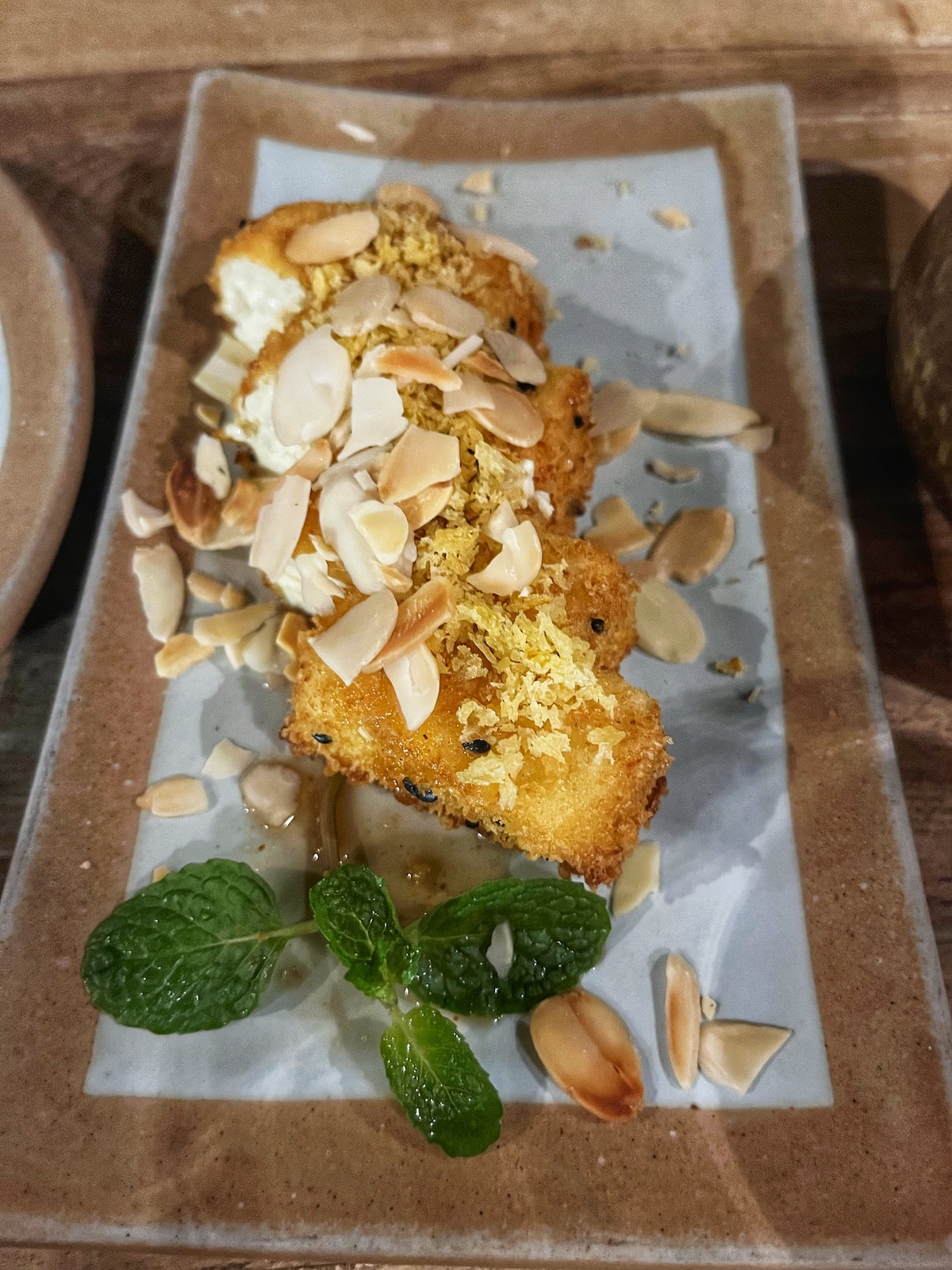
Sadhu Vegetarian Restaurant was established with the vision of providing healthy, vegetarian food that respects the principles of Buddhist vegetarianism. This philosophy is reflected in the menu and the restaurant’s peaceful and welcoming atmosphere. The food is delicious, blending traditional Vietnamese cooking with innovative vegetarian recipes.
I got nine courses and a bottle of wine and only spent around $30. Madness!
Catch Live Music at the Binh Minh Jazz Club
Live music at Binh Minh Jazz Club features a blend of classic jazz standards and contemporary pieces, often infused with a unique Vietnamese twist. Quyen Van Minh ( a pioneer of jazz in Vietnamese) and his band are regular performers most nights after 9 pm, showcasing their deep musicality and passion for this music genre.
The performances are known for their improvisational style, which allows musicians to display their skills and interact with the audience through their instruments. It’s not annoyingly loud like most nightlife in Southeast Asia, and I give the Old Fashioned cocktails a solid seal of approval.
King Roti
It’s now the end of the evening after an epic day of lots of walking around Hanoi. You’ve seen the main man resting at the mausoleum, learned about the fascinating and complex history of the country via its capital city, and been well-fed along the way.
Now it’s time for one more sweet treat from King Roti as you meander back through the Old Quarter to collapse into slumber after a day done with the utmost efficiency.
King Roti specialises in small, baked-to-order rotis (a popular, delicious type of South Asian bread) filled with various sweet ingredients. Their menu includes rotis filled with chocolate, cheese, and fruits like banana and strawberry, often topped or filled with additional sweet sauces.
A truly delicious way to end a perfect day and night in Hanoi.
Was This INTENSE One Day in Hanoi Itinerary Too Much?
Some might look at this one-day Hanoi itinerary and think, “No, thank you. That’s too much for one day.”
I get you.
I prefer doing about half of this in one day, but I had to make time to work on my trip. These activities are so close together that it is possible to do them all in one day, stress-free.
If you have more days in Hanoi, you can spread this out a bit, or if you only have one day in Hanoi, you can remove anything from this suggested itinerary to account for your own tastes.
Enjoy Vietnam’s capital. I’m so glad I made peace with the country after my first visit there… and I still couldn’t care less that I didn’t see the Bourdain/Obama plastic stool.

